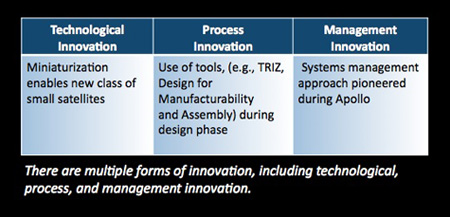August 31, 2010 Vol. 3, Issue 8
Can innovation be taught or learned?
NASA’s ability to execute missions of increasing complexity depends on continuing innovation. So how do we prepare our workforce to innovate?
Let’s start by considering what we mean by innovation. Most talk about innovation centers on technology development. The hybrid automobile, the smart phone, and stem cell transplants are all examples of transformative innovations driven by new technologies. That’s clearly one facet of innovation, but it’s not the only one.
There are also process innovations that produce dramatic gains in efficiency and/or quality. These kinds of innovations can happen at the line level when practitioners are empowered to make improvements, or they can result from the incorporation of best practices or lessons learned. Sometimes process innovations originate internally, while other times they are adapted from the outside.
Similarly, there are management innovations that enable organizations to direct resources in order to meet their objectives. In The Secret of Apollo, historian and NASA engineer Stephen B. Johnson argued that the systems management approach that NASA developed for Apollo was a great innovation that allowed NASA to accomplish its mission. Other innovations such as critical path methodology have been vital to NASA’s success.

Former Cassini project manager Dennis Matson shared a story at the Academy’s second Principal Investigator Forum that captures the innovative spirit of NASA in this age of highly complex projects. By any standard, the original Cassini mission was complex. The science team alone included 260 scientists in 17 countries spanning 10 time zones, making it challenging just to schedule teleconferences. All the scientists involved wanted to maximize the opportunity to conduct experiments on this once-in-a-lifetime mission. All were equally aware that on a flagship mission like this, runaway costs would likely lead to de-scopingthe mission would be simplified, and some science instruments would get cut.
With 18 instruments slated to fly on the spacecraft, Dennis developed a free market system to manage payload reserves. After negotiating contracts with each of the Principal Investigators (PIs) for the instruments, he distributed the payload margin for each instrument—the dollars (per fiscal year), mass (in kg), power (in watts), and data rate to the spacecraft bus (in kilobytes per second)—directly to the PIs. This gave the PIs control over the fate of their respective instruments. He and his team then established a mechanism that enabled the PIs to trade those resources with each other, with all offers and trades recorded electronically. (The project manager, project scientist, and payload manager maintained veto authority over any trade.) The trades became quite complex, sometimes involving three or four parties and a “broker” to facilitate multiparty exchanges. The “Casino Mission,” as the teams dubbed it, established a win-win ethos among the PIs and a strong sense of teamwork. In the end, all 18 planned instruments ended up flying on the spacecraft.
Dennis didn’t learn about resource trading exchanges in a project management training course. Faced with a dynamic environment, he adapted and innovated. In a context where decentralized teams, international partnerships, and working alliances among government, industry, universities, and nonprofit organizations are increasingly the norm, the leadership of complex projects requires the ability to respond rapidly and creatively. In short, it requires innovation.
So what is the role of workforce development in innovation? I would argue that it’s a big one, since learning is a prerequisite for innovation. Professional development activities can promote a culture of innovation and the practice of sharing tools, techniques, and success stories. The Academy supports innovation at NASA by providing courses such as Innovative Design for Engineering Applications (IDEA), which introduces a wide range of tools that engineers can use to help conceive, develop, and test new design concepts. It provides knowledge sharing forums for practitioners like Dennis Matson to exchange stories about innovative ideas, practices, and processes. Its publications and case studies help spread the word about past and current innovative projects at NASA, from Solar Max to LCROSS to FASTSAT.
As long as we continue to explore, the pressure to innovate will always be with us. And in order to innovate, we need to learn.






